parallels of latitude|latitude longitude points on map : Tuguegarao Latitude is the measurement of distance north or south of the Equator, using 180 imaginary lines called parallels. Learn how latitude is measured, named, and . Translation of "flip-flop" into Tagalog . Sample translated sentence: But Julia’s stomach flip-flopped as she walked through the door. ↔ Pero dahil sa nerbiyos nasira ang tiyan ni Julia pagpasok niya sa pintuan.

parallels of latitude,Learn how to measure and locate any place on Earth using the coordinate system of latitude and longitude. Find out the differences between geocentric, .
Learn the definition and examples of parallels of latitude and meridians of longitude, the lines that divide the earth into regions and zones. Find out the difference between . Learn about the imaginary lines that run east to west on the Earth's surface and divide it into five geographical zones. Find out how latitudes and longitudes are . Latitude is the measurement of distance north or south of the Equator, using 180 imaginary lines called parallels. Learn how latitude is measured, named, and .

The Arctic and Antarctic Circles are the parallels of latitude that are roughly 66.5 degrees (66° 33′ 44″ (or 66.5622°). Arctic Circle The region above the Arctic Circle, which includes the North . The Arctic and Antarctic Circles are the parallels of latitude that are roughly 66.5 degrees (66° 33′ 44″ (or 66.5622°). Arctic Circle The region above the Arctic Circle, which includes the North .Planes parallel to the equatorial plane intersect the surface in circles of constant latitude; these are the parallels. The Equator has a latitude of 0°, the North Pole has a latitude of 90° North (written 90° N or +90°), .Circles parallel to the Equator (lines running east and west) are parallels of latitude. They are used to measure degrees of latitude north or south of the Equator. The angular distance from the Equator to the pole is one .parallels of latitude latitude longitude points on map Learn how to measure the north-south and east-west positions of points on Earth using lines of latitude and longitude. Find out the history, methods, and .
Often called parallels or circles of latitude, latitudes are imaginary circles parallel to the equator. On a map where north is up, latitudes run laterally (left to right). They are named after the angle created by a line .Latitude measures the distance north or south of the equator. Latitude lines start at the equator (0 degrees latitude) and run east and west, parallel to the equator. Lines of latitude are measured in degrees north or south of the equator to 90 degrees at the North or South poles. A transcript is available that describes this infographic .
pluviometric equator. parallel, imaginary line extending around the Earth parallel to the equator; it is used to indicate latitude. The 38th parallel, for example, has a latitude of 38° N or 38° S. See latitude and longitude.parallels of latitudeparallel of latitude: 1 n an imaginary line around the Earth parallel to the equator Synonyms: latitude , line of latitude , parallel Examples: show 4 examples. hide 4 examples. Antarctic Circle a line of latitude north of the south pole Arctic Circle a line of latitude near but to the south of the north pole; it marks the northernmost .latitude longitude points on map The latitude -30° or 30°S is a location south of the equator. On a map, these are the lines running horizontally from east-west. Latitude lines are also sometimes called parallels because they are parallel and equidistant from each other. Each degree of latitude is about 69 miles (111 km) apart.

Lines of latitude and longitude form a model called a graticule. Latitude. Latitude (ϕ or phi) specifies the north-south position of a point on the Earth’s surface. Lines of latitude encircle the Earth, running parallel to the equator, so they are also called parallels. Lines of latitude run from 0° to 90° (North or South). Lines of Latitude Each degree of latitude is approximately 69 miles (111 kilometers) apart. At the equator, the distance is 68.703 miles (110.567 kilometers). At the Tropic of Cancer and Tropic of Capricorn (23.5 degrees north and south), the distance is 68.94 miles (110.948 kilometers). At each of the poles, the distance is 69.407 miles (111.699 kilometers). line of latitude at 66.5 degrees south that encircles the continent of Antarctica. Arctic Circle. noun. paralell of latitude that runs 66.5 degrees north of the Equator. Greenwich meridian. noun. imaginary line around the Earth, running north-south at 0 degrees longitude. Also called the prime meridian. latitude.Verified by Toppr. Parallels of latitudes: All of the imaginary circles parallel to the Equator are called parallels of latitudes. These circles have varying centres and all these central points lie on the same line: the axis of the earth. Meridians of longitudes: All of the imaginary circles perpendicular to the Equator are called meridians of .
parallels of latitude|latitude longitude points on map
PH0 · parallel of latitude on map
PH1 · latitude longitude points on map
PH2 · earth parallels of latitude labels
PH3 · difference between parallels and meridians
PH4 · Iba pa
PH5 · 55 degrees geomagnetic latitude
PH6 · 38th parallel website
PH7 · 37 parallel map
PH8 · 36 parallel map